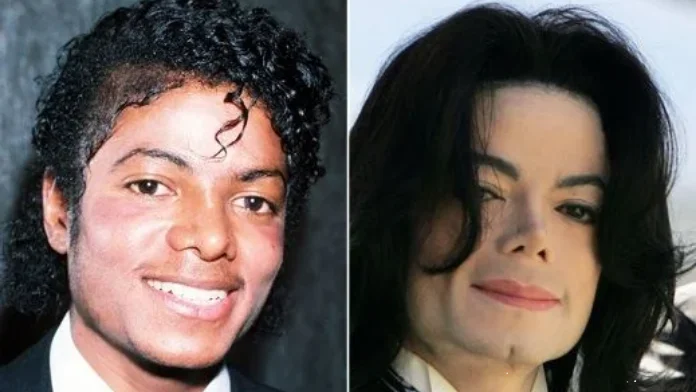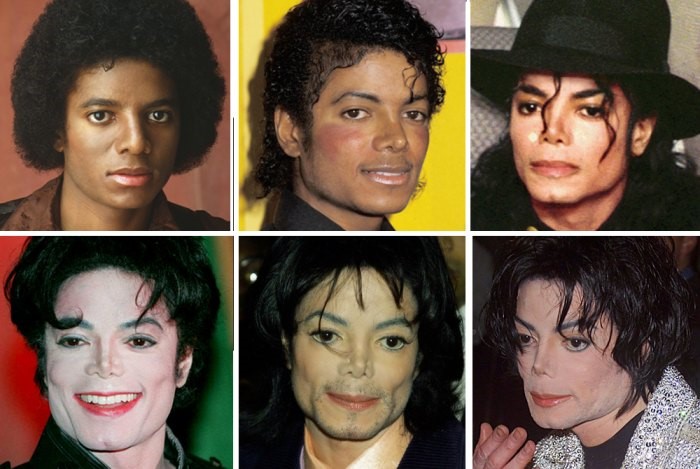Michael Jackson’s transformation captivated fans for years, earning him the title of the “man of many faces.” His iconic appearance, marked by disguises and surgical alterations, stirred constant intrigue. While Jackson publicly admitted to just two nose jobs, hints from his former wife, Lisa Marie Presley, suggested more extensive procedures. A Los Angeles surgeon, Dr. Wallace Goodstein, who shared a practice with one of Jackson’s surgeons, revealed the pop icon’s frequent visits for various surgeries, including nose jobs, cheek implants, and a chin cleft.
Despite efforts to conceal these operations, Jackson’s face bore the marks of numerous surgeries, as his nose became very small from being operated on repeatedly. A decade after his passing, Jackson’s legacy lives on, leaving fans with lingering questions about his plastic surgery journey, marking an enduring chapter in pop culture history.
Michael Jackson Before Surgery
MJ’s face stands as one of the most iconic in the entertainment industry to date. Despite his denials, a careful examination of Michael Jackson’s before-and-after plastic surgery images reveals a series of procedures aimed at enhancing facial symmetry and restoring youthful vitality. These enhancements included a nose job, eye lifts, and cheek implants.
Initially, in March 1971, Jackson possessed a cherubic countenance with doe eyes and a melodious voice, endearing him to countless fans. Around 1973, as he embarked on his solo career, puberty subtly transformed his face, sculpting a more masculine jawline.
Despite his soaring fame and adoration, Jackson battled insecurities, particularly regarding his acne-prone skin and nose, which had earned him the unkind nickname “big nose” from his brothers. By the age of 18, Jackson’s fame had surpassed that of his siblings, yet his dissatisfaction with his appearance persisted. His quest for acceptance and the desire to address perceived flaws preceded his experimentation with cosmetic procedures.
Michael Jackson’s Plastic Surgery
Michael Jackson underwent a series of plastic surgeries in his quest for facial symmetry and a more youthful appearance. Starting in the late 1970s due to a nose injury, his transformation became noticeable in the mid-1980s, marked by significant changes to his nose and skin tone. These alterations, including a nose job, eye lifts, cheek implants, and other enhancements, led to widespread speculation about extensive cosmetic procedures.
The journey began in the late 1970s when Michael Jackson broke his nose in a dance accident, leading to his first plastic surgery. Interestingly, he was so anxious about the initial rhinoplasty that he convinced his older sister, La Toya, to undergo a similar procedure as a test case. Despite his initial apprehension, he continued to consult doctors due to breathing issues with his new nose.
Evidence also pointed to additional treatments like Botox, fillers, skin bleaching, cheek implants, and lip augmentation. There are also speculations regarding his undergoing forehead lifts, cheekbone alterations, and lip surgeries. After his passing, postmortem examinations revealed eyebrow and hairline tattoos, indicating efforts to enhance his appearance. Experts, such as Dr. Eda Gorbis, suggested that his numerous procedures might have been influenced by body dysmorphic disorder.
Why Was Michael Jackson White?
Throughout his life, Michael Jackson faced numerous controversies, one of which was the transformation of his skin color from dark to white. He attributed this change to vitiligo, a skin condition that erases pigmentation. Despite public skepticism, he strongly denied deliberately lightening his skin and stressed his dedication to being genuine.
Dermatologist Dr. Hanish Babu supported Jackson’s explanation, suggesting the transformation could be attributed to Benoquin, an FDA-approved treatment for vitiligo. Initially, Jackson attempted to conceal white patches with makeup matching his original skin tone. As the patches increased, he turned to bleach with 20% Benoquin Cream under medical supervision.
Following Jackson’s death in 2009, his autopsy confirmed the vitiligo diagnosis, noting patches of light and dark-pigmented areas. Benoquin and hydroquinone tubes were also discovered among his medications, revealing that he did use this FDA-approved treatment for vitiligo. Microscopic examination of his skin also revealed a lack of pigment and a reduced number of melanocytes, which is most consistent with vitiligo, with or without the use of Benoquin, and vitiligo was the official diagnosis on the report.
Dr. David Sawcer observed that some vitiligo patients opt for depigmentation due to widespread pale skin. This choice, besides changing his complexion, made Jackson susceptible to sunburns, prompting him to cover up when outdoors. While Jackson’s exact motive for skin bleaching remains private, it is indisputable that he had vitiligo. He used Benoquin, an FDA-approved vitiligo treatment, not to “become white” but to manage his condition.
Did Michael Jackson Bleach his Skin?
Michael Jackson consistently denied purposefully bleaching his skin, attributing his lighter appearance to makeup used to even out his skin tone. Despite rumors, close family and friends never confirmed his use of bleaching products.
While he did use cream to depigment his skin due to vitiligo, the intention behind it remained private. Celebrity sources like J. Randy Taraborelli and director John Landis speculated about his skin whitening methods, with Landis mentioning Jackson’s bleached chest. Some psychologists criticized Jackson’s influence on black youth, while others defended him.
The Popstar addressed the rumors in a 1993 interview with Oprah Winfrey, emphasizing his pride in his black heritage and revealing his vitiligo condition. He expressed pride in his black heritage and emphasized that he always identified as a black man, regardless of his white skin resulting from vitiligo.
During the interview, Jackson dismissed the notion of skin bleaching, stating he had never seen or practiced it. He revealed his struggle with vitiligo, a condition causing pale patches on his skin, for which he used makeup to achieve an even tone. He expressed his frustration with false stories about him wanting to change who he was, highlighting the uncontrollable nature of his condition. Jackson also pointed out the double standard, questioning why people don’t criticize those who deliberately tan to become darker.
However, there is ongoing speculation about whether Jackson truly had vitiligo. Some skeptics suggest that he might have deliberately bleached his skin using Benoquin cream and other medical treatments, given that tubes of Benoquin and hydroquinone were discovered in his home. According to David Sawcer, these creams are commonly for vitiligo patients like Jackson, who may remove dark patches of skin when the majority of their skin has turned pale.
Jackson concealed his condition by wearing long-sleeved clothing and pants, using light-colored makeup, and potentially prescription skin-bleaching creams. These measures would have further lightened his skin and, coupled with makeup application, allowed him to appear very pale.
What Was Michael Jackson’s Skin Condition?
Michael Jackson was diagnosed with vitiligo, a skin disorder causing white patches and sensitivity to sunlight. This condition, leading to depigmentation and visible white spots, often emerges between ages 10 and 30. In Jackson’s case, it ran in his family, and he inherited it from his father. He began noticing pale spots during his teenage years and used fair-colored makeup and skin-bleaching creams to mask the uneven skin color caused by vitiligo.
The Popstar publicly disclosed his skin condition during a 1993 interview with Oprah Winfrey, revealing that the changes began after his 1982 album “Thriller.” At the time of the interview, he had been dealing with the condition for about a decade. He started wearing a single white glove in 1983, around the same period his vitiligo began. The glove, initially worn due to localized vitiligo on his hand, eventually became a signature element, allowing the audience to follow his rapid hand movements during performances.
Upon Jackson’s request after his interview with Oprah, his dermatologist, Dr. Arnold Klein, publicly confirmed his condition in 2009. Dr. Klein revealed that Jackson had been diagnosed with vitiligo in 1984 and also disclosed that Jackson suffered from lupus erythematosus. This condition not only poses serious health risks but can also result in the loss of skin pigmentation.
Dr. Klein further revealed that Jackson sought his assistance for his vitiligo, and his condition worsened, resulting in a speckled appearance on his face and hands. Traditional treatments failed, leading them to use specific creams, likely hydroquinone derivatives, to balance pigments. This approach, confirmed through Jackson’s autopsy, resulted in a uniform but pale skin tone. Jackson’s medical history included a vitiligo diagnosis, and he used FDA-approved treatments like Benoquin 20% cream, BQ/KA/RA formulation, hydroquinone 8% lotion, and UVA Anthelios XL sunscreen.
Michael Jackson’s Transformation
Michael Jackson acknowledged having a nose job, but despite his claim of no other facial surgeries in a 2003 documentary with Martin Bashir, it has been disclosed that he underwent multiple procedures to alter his appearance.
1. Nose: Michael Jackson’s nose underwent significant changes over time, transitioning from a wide-set appearance reflective of his ethnic background to a narrower shape. This transformation, along with autopsy findings revealing surgical scars near each nostril, strongly indicates he underwent rhinoplasty. Reports initially suggested extensive nose surgeries, but Jackson clarified in his 1988 autobiography, ‘Moonwalk,’ that he had only undergone two rhinoplasties. Following his passing, Dr. Klein revealed he had reconstructed Jackson’s nose due to collapsed cartilage and Jackson’s extreme pain sensitivity.
2. Hair: Michael Jackson originally had natural Afro hair, but as his career progressed, he used chemical texturizing to relax it. Following the well-known Pepsi incident, where his head caught fire, there were speculations about him wearing wigs to cover bald patches. However, the autopsy report revealed that he had opted for semi-permanent tattooing on his scalp as a non-surgical method to conceal his hair loss.
3. Lips: Jackson’s lips underwent a transformation, thinning with age and gaining a pinker hue. Autopsy reports revealed the presence of semi-permanent tattooed ink on and around his lips, providing an explanation for this alteration.
4. Chin: In his 20s, Michael Jackson opted for a chin implant, resulting in a noticeable cleft in his chin that was absent during his childhood. This alteration could have been achieved through a chin implant or, in certain cases, with dermal fillers. Unfortunately, the autopsy report does not provide additional details, leaving us uncertain about the specific method used.
5. Breast Implant: Michael Jackson reportedly had breast implants in the early 1990s. He had them removed by 2010.
6. Facial Structure: Facial surgeons speculated that Michael Jackson underwent procedures such as a forehead lift, cheekbone surgery, and lip alterations. However, Jackson claimed that his changed appearance was due to a dimple created in his chin and natural factors like puberty, a vegetarian diet, weight loss, different hairstyles, and stage lighting. He denied altering his eyes and explained his cheekbones, stating they were hereditary features from his father’s Indian heritage. Despite his explanations, Michael Jackson faced accusations of plastic surgery and rumors about Botox injections to reduce eye creases.
Michael Jackson Through the Years
First Nose Surgery (1979)
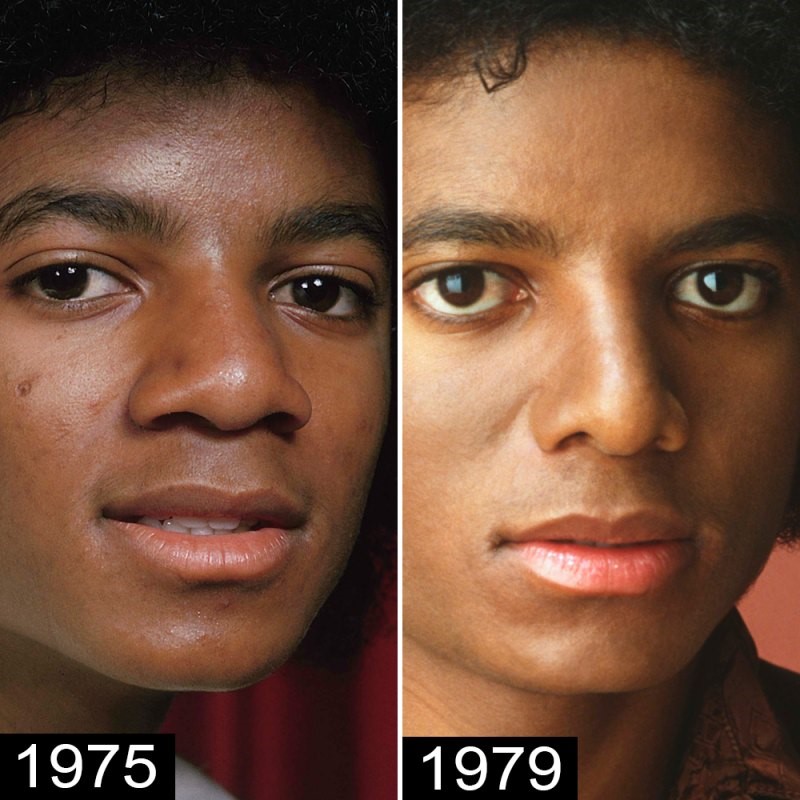
In 1979, Michael underwent his initial nose surgery, coinciding with the release of his fifth solo album, Off the Wall. At the age of 21, after breaking his nose during a dance rehearsal, he opted for his first rhinoplasty to correct it. This marked the beginning of his significant transformation through plastic surgery.
Second Nose Surgery (1983)
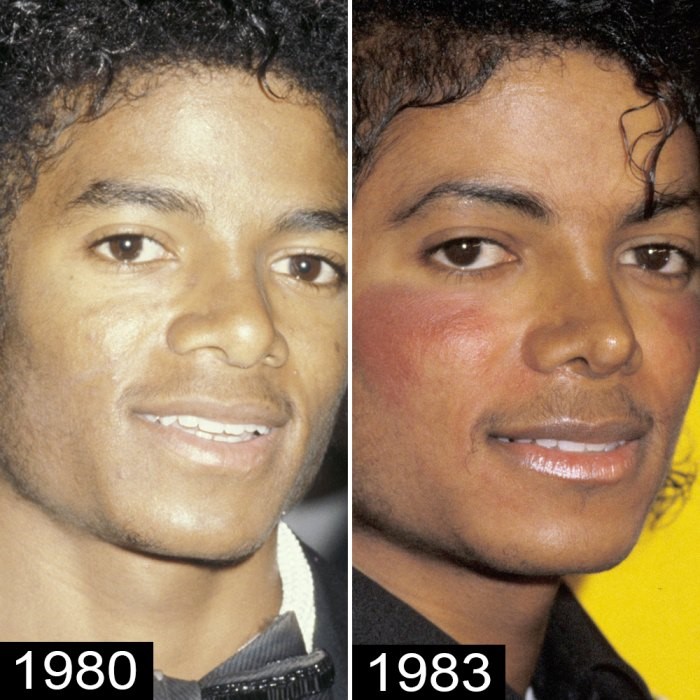
In 1980, Michael Jackson underwent a significant transformation. He traded his teenage afro for a different look, using skin-lightening make-up. Despite his initial nose job, he wasn’t content and opted for a second procedure to refine it. By 1983, his nose appeared thinner, and he embraced his iconic curly hair, marking a distinct departure from his seventies style.
Third Nose Job (1986)
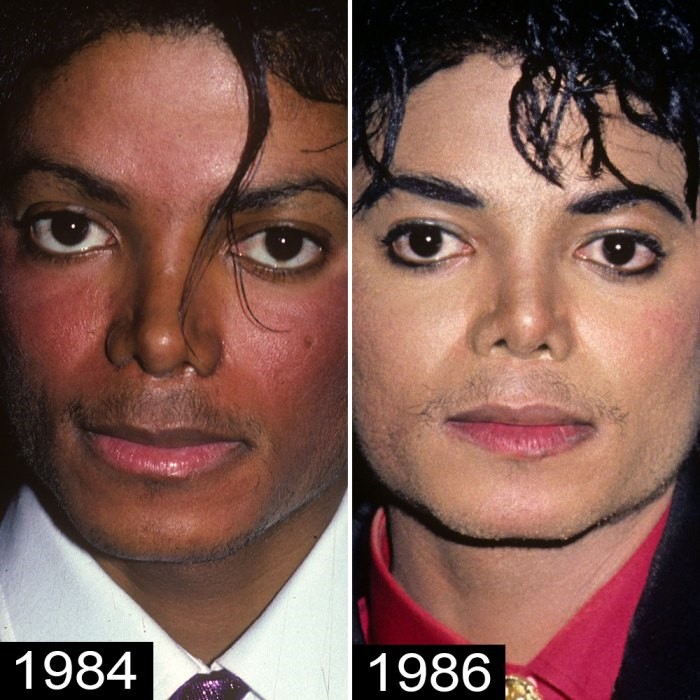
Dr. Steven Hoefflin, the plastic surgeon responsible for Michael’s procedures, explained that the second nose job caused breathing difficulties and necessitated additional adjustments. In the third surgery, Hoefflin corrected the deviated septum and refined the nose for a more natural look.
Chin Implant (1988)
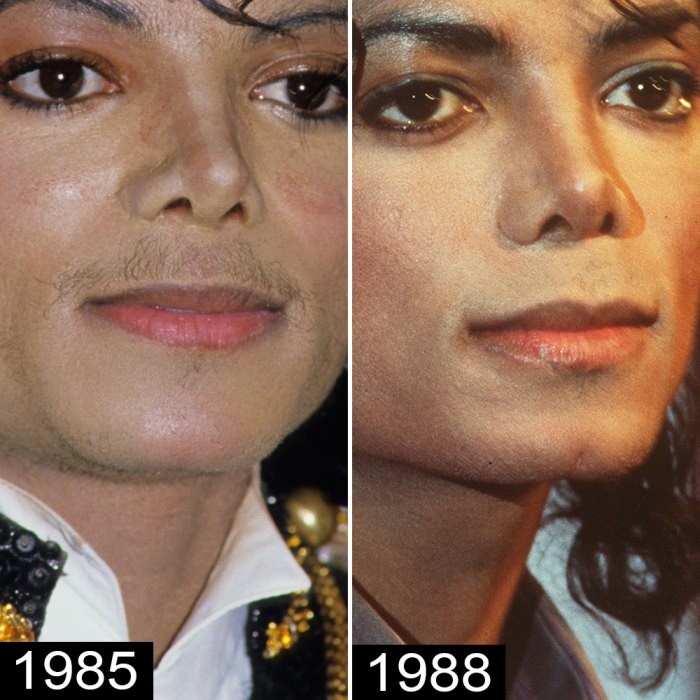
In 1988, a noticeable change occurred on Michael Jackson’s face – a cleft appeared on his chin. At the 1989 Soul Train Awards in Los Angeles, Jackson showcased not only a thinner nose and heavily lined eyes but also a more prominent cleft chin. During a 2003 interview with ABC News, plastic surgeon Pamela Lipkin asserted that these transformations couldn’t have occurred naturally. According to her, the distinct cleft on Jackson’s chin was not natural; it had likely been created through a surgical procedure.
Skin Color
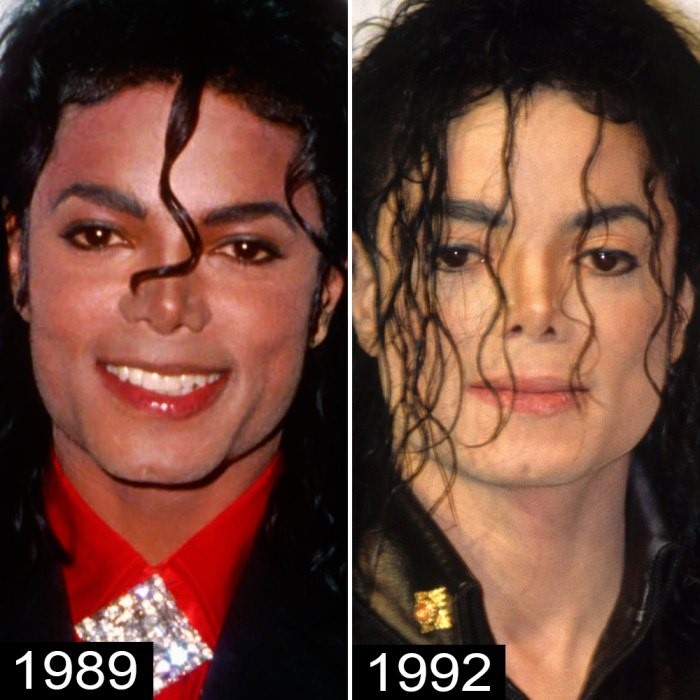
In 1992, Michael Jackson underwent multiple surgeries, including nose jobs and chin implants, leading to noticeable changes in his appearance. His nostrils took on a triangular shape, and he developed a dimple in his chin. He also claimed his lighter skin tone was due to vitiligo. Dr. Wallace Goodstein, who collaborated with Michael’s surgeon during the ’90s, revealed that Jackson had surgeries approximately every two months, totaling around 10 to 12 procedures within two years during that period.
Entire Face Surgery (1995)
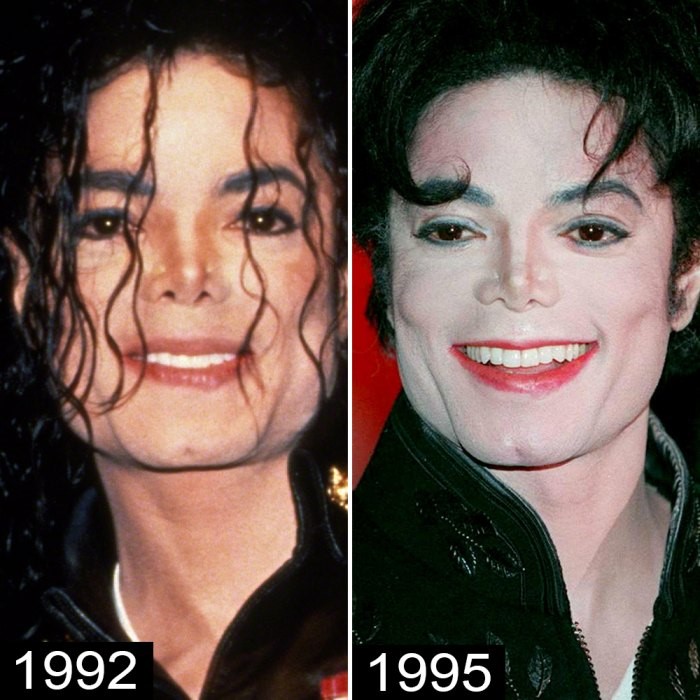
In 1995, at 36 years old, Jackson underwent a startling transformation. His changed look, marked by wider eyes, a square jaw, and a shorter haircut, bore little resemblance to his previous self. His skin, notably pale due to a skin condition, further accentuated his altered appearance. According to his friend Uri Geller, Jackson shared that he made these changes to deliberately distance himself from his father’s likeness.
Face

In the year 2000, the changes in Michael Jackson’s face were so significant that it became difficult to determine the specific procedures he had undergone. According to Dr. Goodstein, he had multiple nose jobs, cheek implants, and even a cleft put in his chin. He also had eyelid surgery and more. By 1997, as his career declined, Jackson adopted a new appearance with longer, straighter hair.
Nose Surgery and Tattooed Eyebrows
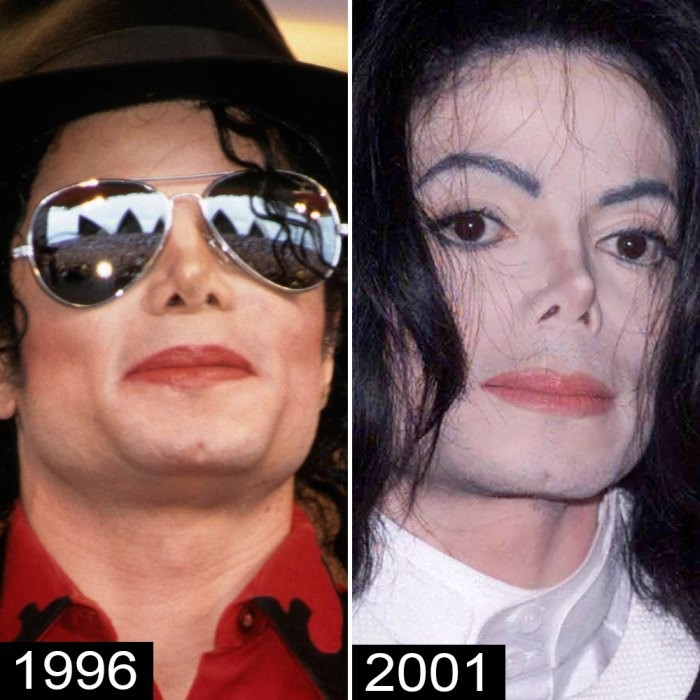
In November 2001, Jackson’s eyebrows hinted at possible surgical procedures. Lipkin, speaking to ABC News in 2003, speculated that Jackson likely underwent a forehead or brow lift. She also spoke about his nose, which appeared to be thinner than ever, suggesting his nose had undergone numerous surgeries, leaving it unable to function properly. According to Lipkin, Jackson had reached a stage where his nose was irreversibly altered, making breathing difficult.
Nose Indentation

In a 2003 documentary with Martin Bashir, Michael Jackson admitted to undergoing a nose job for improved breathing and higher vocal range. He stated, ‘I’ve had no plastic surgery on my face, just my nose.’ However, subsequent procedures led to complications, causing his nose to deteriorate. By 2005, after multiple nose surgeries, his nose began to collapse. Dr. Arnold Klein revealed in 2009 that he used fillers, specifically hyaluronic acids, to rebuild Michael’s nose. This intricate process required precision to achieve a smooth result.
FAQs
Did Michael Jackson Have Vitiligo?
Michael Jackson indeed had vitiligo, a condition that caused the loss of skin pigmentation. It began with small spots and gradually spread across his body.

